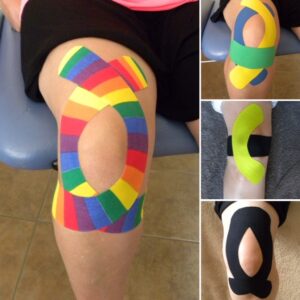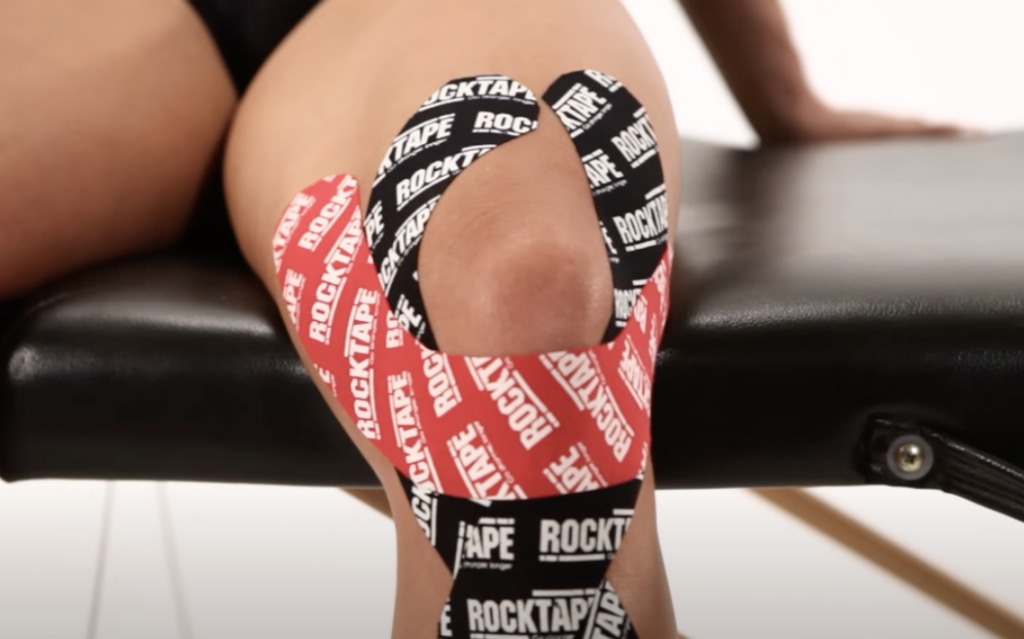Therapeutic Hug – Give Your Creaky Knees Some Love
Over the past 5 years, kinesiology tape (also known as K-Tape or Elastic Therapeutic Tape) has become an increasingly popular treatment option for individuals with knee osteoarthritis. Knee osteoarthritis is a common condition that causes the degeneration of the cartilage in the knee joint, leading to pain, stiffness, and reduced mobility. Kinesiology tape is a type of adhesive tape that can be applied to the skin to provide a gentle stimulus to local touch receptors that have been, clinically shown to reduce pain and improve function with those experiencing knee symptoms. In this post, we will explore the science behind kinesiology tape for knee osteoarthritis and its application as a treatment option.
The Science Behind Kinesiology Tape for Knee Osteoarthritis
Unfortunately, there still remains a lot of confusion around the science of this form of therapy due to previous missteps in the research of elastic taping. For many years, researchers have been attempting to support or refute claims that tape would either facilitate or inhibit a muscle. As you would expect, the answer was consistently demonstrating that this form of taping, regardless of how it’s applied (origin to insertion and vice versa), had little to no effect on muscle activation.
The problem was that they were asking the wrong questions in those studies, leading to a negative bias against the use of this type of therapy. Fortunately, over the past 5-10 years, the research community has rebounded and started asking more pertinent questions as they relate to kinesiology taping, inquiring about pain, mobility, and function as the key outcomes to be tested. We now have several papers, including a 2020 systematic review by Melese and colleagues of eighteen randomized trials involving 876 patients, demonstrating that there is a significant difference between taping groups and control groups in terms of pain and function. It was concluded that kinesiology taping is an effective option for improving pain and joint function in patients with knee OA.

Application of Kinesiology Tape for Knee Osteoarthritis
To apply kinesiology tape for knee osteoarthritis, the following steps can be taken:
- Clean the skin: Clean the skin around the knee joint with soap and water (alcohol wipes) to remove any oils or lotions.
- Measure & trim the tape: Measure the appropriate length of kinesiology tape needed to cover the affected area (2-3 strips) and round the edges to maximize the longevity of the tape on the body (generally 3-5 days)
- Apply the tape: Apply the tape to the skin in the desired pattern, ensuring that the skin is stretched to a comfortable position.
- Rub the tape: Rub the tape gently to activate the adhesive and ensure that the tape is securely attached to the skin.
- Wear the tape: Wear the tape for several days, removing if you experience any signs of redness and/or itchiness (very low risk)
Check out a simple-to-follow video tutorial – Click Here.
Need tape? Ket you tape here
Note: When applying kinesiology tape for knee osteoarthritis, it is important to follow proper application techniques to ensure that the tape is safe, effective and comfortable. If you are experiencing knee pain, talk to your healthcare provider to determine if kinesiology tape is right for you.
Conclusion
Kinesiology tape can be an effective treatment option for individuals with knee osteoarthritis. It works by providing support to the nervous system, improving body awareness, mitigating pain perception, and optimizing our natural healing capacity.
By Steve Capobianco, D.C., MA.DACRB, CSCS, PES
More blogs about knee pain here
References:
Melese H, Alamer A, Hailu Temesgen M, Nigussie F. Effectiveness of Kinesio Taping on the Management of Knee Osteoarthritis: A Systematic Review of Randomized Controlled Trials. J Pain Res. 2020 May 28;13:1267-1276.
